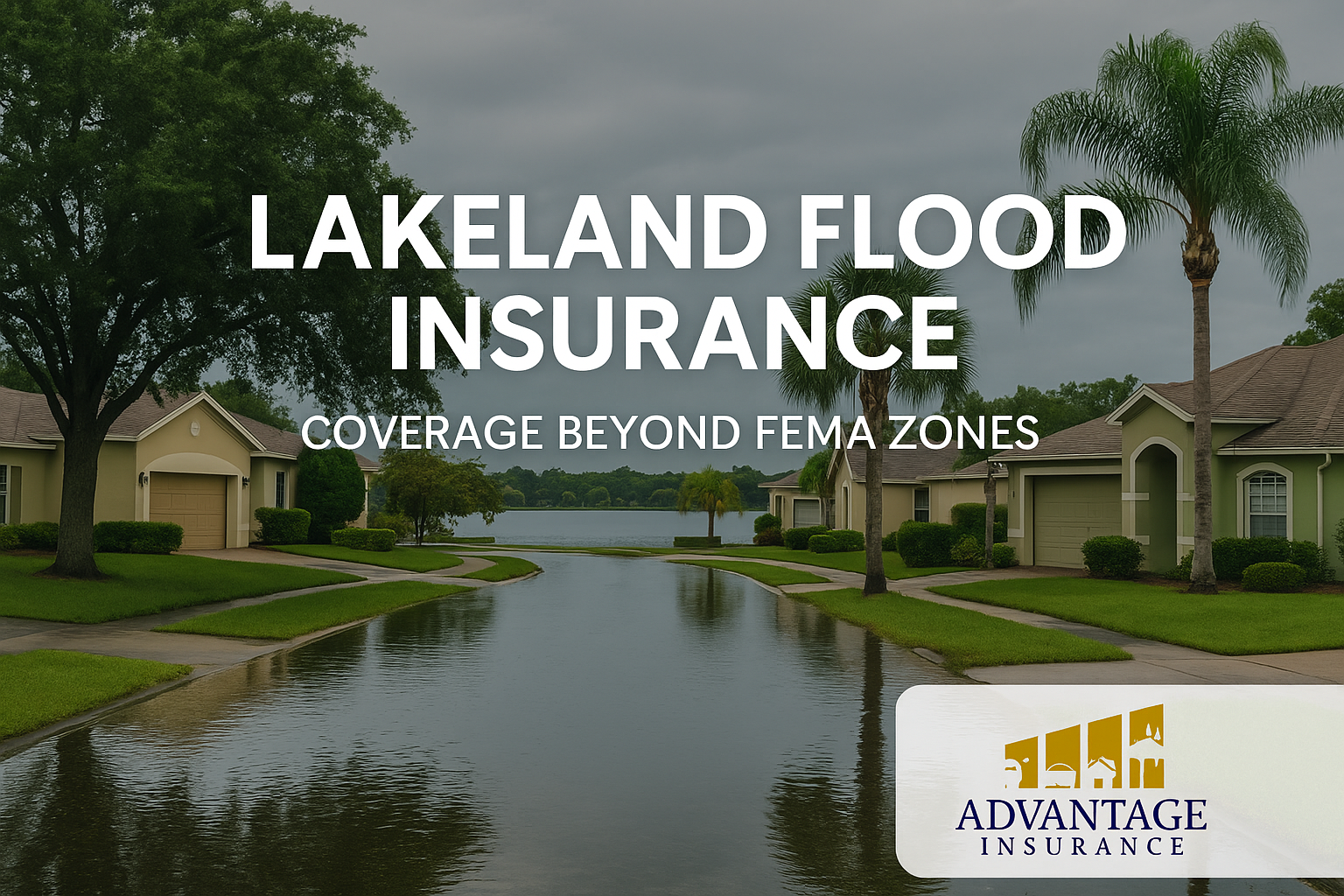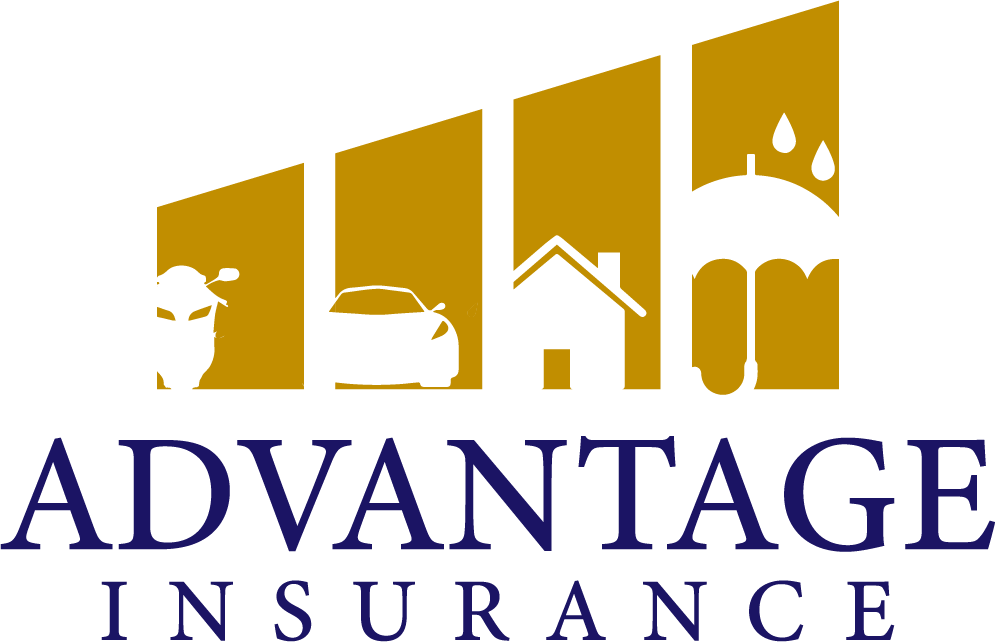
Lakeland Flood Insurance
Flooding isn’t just a coastal problem – as many Lakeland residents have learned, heavy rains and overflowing lakes can cause serious flood damage here in Central Florida. If your home is near one of our 38 lakes or in a low-lying area, flood insurance is a wise investment (and may be required by your mortgage). Advantage Insurance helps Lakeland homeowners, renters, and business owners secure reliable flood coverage through the National Flood Insurance Program (NFIP) or private insurers, so you’re protected when the waters rise.
For Lakeland flood insurance, it’s crucial to understand the local risks and how they can impact your property. Ensuring you have the right coverage can provide peace of mind during heavy rainfalls.
Understand Your Flood Risk in Lakeland
True to its name, Lakeland has abundant water bodies – from Lake Hollingsworth and Lake Parker to the Peace River on our edge. While we’re inland from hurricanes’ storm surge, tropical systems can dump immense rain. In 2017, Hurricane Irma deluged Polk County, and in 2022, Hurricane Ian’s rainfall pushed the Peace River to near-record levels (10.8 feet), inundating some areas. Even slower-moving summer thunderstorms can overwhelm drainage, especially in older neighborhoods or those near wetlands.
When considering Lakeland flood insurance, knowing the specific flood zones can help you make informed decisions about your coverage needs.
FEMA Flood Zones: Every property is in a FEMA flood zone, which indicates its risk. High-risk zones (A or AE zones) are areas with a 1% annual chance flood (100-year floodplain). If you’re in one of these and have a federally-backed mortgage, flood insurance is required by law. Parts of Lakeland along creek beds or around lakes are designated Zone A/AE. Moderate risk zones (X-shaded) and low risk (X) don’t require insurance, but that doesn’t mean no risk – about 20-25% of flood claims come from these “lower risk” zones. We can help you look up your flood zone and past flood maps for your address. The City’s online flood info tool is a great resource.
Many homeowners in Lakeland choose to invest in flood insurance to protect against the unexpected costs associated with flood damage.
Community Flood Mitigation: Lakeland participates in the NFIP’s Community Rating System program and currently has a Class 7 rating. This is good news – it means policyholders in high-risk zones get an automatic 15% discount on NFIP flood premiums due to the city’s flood mitigation efforts. Polk County (unincorporated) holds a Class 6 (20% discount). The city has invested in better drainage, floodplain management, and public education to reduce flood risk, but individual homeowners still need insurance for financial protection.
Community efforts to mitigate flood risks greatly enhance the effectiveness of your Lakeland flood insurance policy.
NFIP Policies and Coverage
The National Flood Insurance Program is the primary source of flood insurance for most. NFIP policies have standard coverage limits: up to $250,000 for building and $100,000 for contents (for residential properties). They cover flood damage to your home’s structure and foundation, electrical and plumbing systems, appliances, flooring, and personal belongings (actual cash value for contents). However, NFIP does not cover additional living expenses (temporary housing) after a flood – something to be aware of. There’s typically a 30-day waiting period from purchase to when coverage takes effect, so don’t wait until a hurricane is on the radar to buy a policy.
If you own property in Lakeland, flood insurance is a necessary financial tool to protect your investment.
Premiums are set by FEMA’s Risk Rating 2.0 system nowadays, which looks at your home’s individual risk factors (distance to water, elevation, rebuild cost, etc.). In Lakeland, NFIP premiums can vary widely – we’ve seen some low-risk homes under $500/year, while lakefront homes or those in bowl-like terrain might be $1,000+ per year. As independent agents, we can quote your NFIP rate instantly and also check if a private flood insurance market could beat it.
Private Flood Insurance Options
Private flood insurance options also exist for homeowners seeking alternatives to NFIP policies in Lakeland.
In recent years, private insurers have started offering flood insurance in Florida with competitive rates and higher coverage limits. Advantages of private flood policies can include:
- Higher coverage limits: If you need more than $250k building coverage (say for a high-value home) or want contents coverage above $100k, private markets can accommodate that.
- Shorter wait times: Some private policies don’t enforce the full 30-day wait, or waive it for loan closings or if a storm isn’t imminent.
- Additional living expense coverage: Many private flood insurers include loss of use, so if you have to live elsewhere during flood repairs, those costs are reimbursed – something NFIP lacks.
- Potentially lower premiums: Depending on your property’s risk profile, a private insurer might offer a better rate than the NFIP. We’ll compare both for you.
We work with reputable private flood insurers that are backed by strong reinsurers. If you qualify, we’ll present those options alongside the NFIP quote. Keep in mind, mortgage lenders accept private flood policies as long as they meet regulatory requirements.
Don’t Rely on Disaster Aid Alone
After a major flood, you might expect FEMA assistance – but federal disaster aid is not a reliable safety net. First, an official disaster declaration has to happen (which isn’t guaranteed for smaller flood events). Even when it does, typical FEMA grants for individuals are only a few thousand dollars, and loans must be paid back. By contrast, a flood insurance payout can fully cover tens or hundreds of thousands in damages. For example, one foot of water in a 2,000 sq. ft. home can cause $50,000+ in damage (flooring, drywall, cabinetry, appliances all ruined). Flood insurance is the only thing that will cover that in full. It’s peace of mind that your home and savings are protected.
After a major flood, your Lakeland flood insurance may be the only thing that fully covers the damages to your home.
Remember, floods can happen in unexpected areas. In 2021, parts of Lakeland not in flood zones saw street flooding from summer storms; in 2019, intense rain caused Lake Hunter to overflow into yards. If you’re unsure of your risk, talk to us – we’ll give an honest assessment. Flood insurance in lower-risk zones is often quite affordable, and we’ve seen too many cases where those with “optional” policies were grateful they had it when an unusual flood struck.
Considering Lakeland flood insurance is smart, especially for those living near local lakes and rivers.
Lakeland Flood Insurance FAQs
Is flood insurance required for homes in Lakeland?
It’s vital to ask whether your lender requires Lakeland flood insurance and what type of coverage you need.
It depends on your location and lender. If your property is in a FEMA-designated high-risk flood zone (Zone “A” or “AE”) and you have a mortgage from a federally regulated lender, yes – you’re required to carry flood insurance. Many homes around lakes or low areas of Lakeland fall into this category. If you’re in a moderate or low-risk zone, it’s usually not required by lenders, but it’s still recommended. About 1 in 4 flood claims occur outside the high-risk zones, so even if it’s not mandatory, consider your proximity to water and drainage. We can help determine if your address requires it and provide a quote either way.
How much does flood insurance cost in Lakeland?
Flood insurance premiums in Lakeland vary. For a home in a low-risk X zone, an NFIP policy might be only a few hundred dollars per year – sometimes $400-$600 for moderate coverage. In higher-risk zones near water, it could be closer to $1,000 or more annually. Factors like your home’s elevation, distance to a lake or river, and even how many floors the home has (one-story vs two-story) will influence the rate under FEMA’s rating system. Private flood insurers also offer competing rates – in some cases lower, in others higher. The best way to find out your cost is to get a quote. We’ll gather some basic info (address, year built, etc.) and can provide you with both NFIP and private flood insurance quotes for comparison.
Many residents in Lakeland find that investing in flood insurance pays off after experiencing severe weather conditions.
What does a flood insurance policy cover (and not cover)?
A standard NFIP flood policy covers direct physical losses from flooding to your building and personal property. This includes your home’s structure, foundation, electrical and plumbing systems, AC units, kitchen appliances, flooring, drywall, etc. Personal belongings like furniture and clothing are covered (up to the contents limit) on an actual cash value basis. It does not cover the land, landscaping, pools, or decks. It also doesn’t cover temporary living expenses if you have to move out during repairs – that’s a key difference from homeowners insurance. Private flood policies may add some coverage like loss of use. Also note, there’s usually a small deductible (often $1,000 or $2,000). We’ll go over the specifics of coverage and any exclusions so you know exactly what protection you’re buying.
Understanding what your Lakeland flood insurance covers can help you avoid surprises during a claim.
Can I buy flood insurance right before a hurricane?
No, you need to plan ahead. NFIP policies have a 30-day waiting period after purchase before coverage kicks in (with few exceptions like loan closings). Private flood insurers may have shorter waits (some as low as 15 days), but crucially, once a storm is forming and threatening Florida, almost all insurers (including NFIP) stop binding new policies until the event passes. For instance, if a named storm is forecasted to impact Florida within a week, you generally can’t start a new flood policy. That’s why we urge homeowners to get flood insurance in place at the start of hurricane season (or anytime, really) rather than waiting until the last minute. Don’t gamble with that waiting period – get covered well ahead of any storm.
Each year, residents are reminded of the importance of securing Lakeland flood insurance against possible flooding events.
It’s essential to have Lakeland flood insurance in place before disaster strikes.
Ultimately, choosing the right Lakeland flood insurance policy can be a life-changing decision for many families.
The peace of mind that comes from having Lakeland flood insurance is invaluable to homeowners.
Be proactive about your Lakeland flood insurance to safeguard against the inevitable weather challenges.
Always consider the timing of your Lakeland flood insurance purchase to ensure coverage is in place when you need it most.
